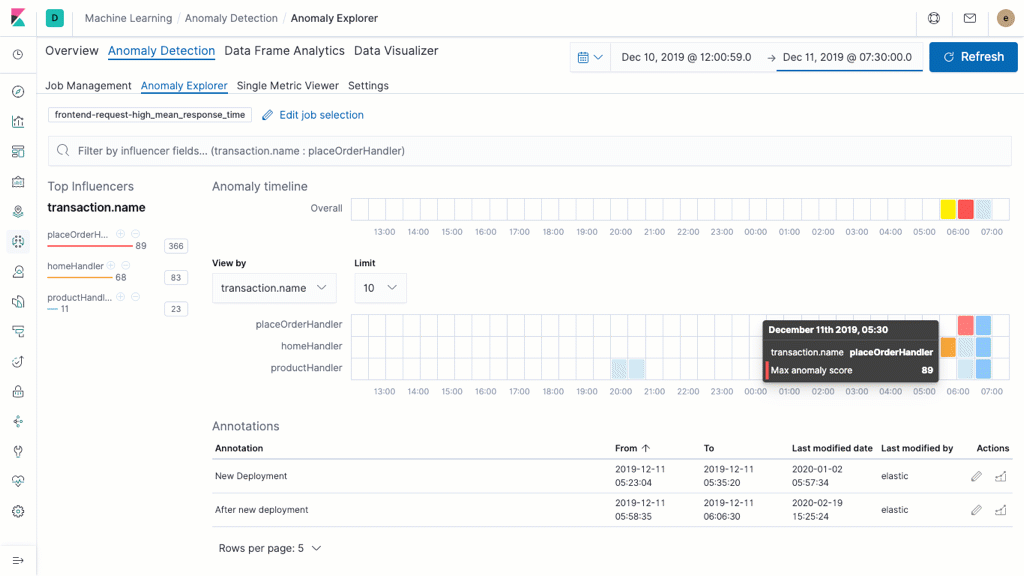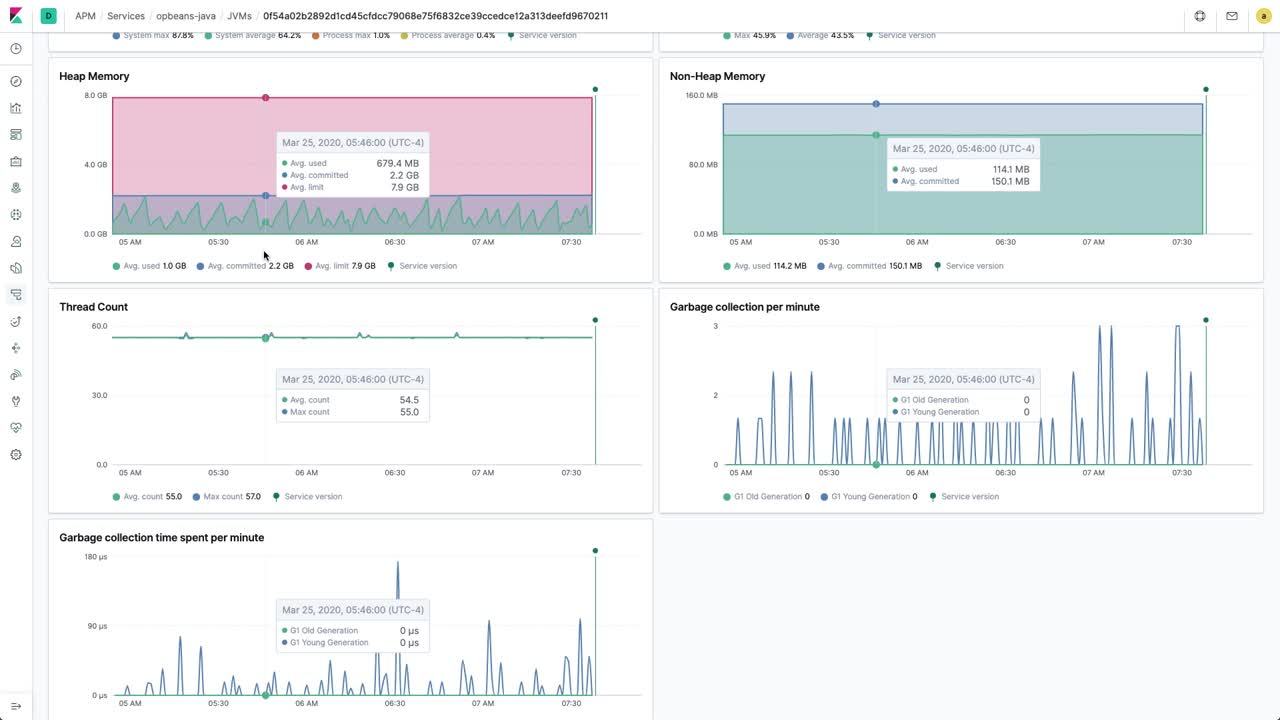Elastic APM: Free and open application performance monitoring
Application performance monitoring (APM) is a critical part of a unified observability strategy. APM offers deep insights into application performance and behavior, and organizations depend on it to deliver performant and high-quality digital experiences to their customers — both for keeping a proactive pulse on the health of their applications and for troubleshooting issues.
Elastic APM, a free and open APM product built on the Elastic Stack, is an integral piece of the Elastic Observability solution. Combined with our Logs, Metrics, and Uptime products, it gives organizations unified visibility into their applications, helping them quickly detect, investigate, and resolve problems before they impact customers.
Interested in APM?
Learn how to set up agents, utilize distributed tracing, and correlate traces, logs, and metrics with Elastic Observability.
Feature-rich and powerful
Elastic APM is designed to help you monitor software services and applications in real time, making it easy to detect and resolve performance problems quickly. Its broad full-stack capabilities include language support for Java, .NET, Go, Node.js, Python, and Ruby. It also supports client-side JavaScript technologies such as the React and Angular frameworks, enabling real user monitoring (RUM) for all users. Plus, we’re always adding support for new and emerging full-stack technologies. In addition to out-of-the-box support, Elastic APM is open and allows you to build your own support and/or tap into the open source community to support additional full-stack technologies.
Features like distributed tracing make pinpointing errors in microservices and distributed architectures easy, and support for open standards like OpenTracing makes moving existing OpenTracing instrumentation to Elastic APM hassle-free.
Free and open. For everyone. At any scale.
Since the early days of Elastic, we’ve focused on delivering a frictionless getting started experience to our community. Whether you’re a developer at a small non-profit or a large enterprise, you should be able to go from idea to production with ease. When we remove barriers, magic happens. "Free and open" is a big part of that promise, and we bring that philosophy to Elastic APM as well.
But free and open doesn’t stop with getting started. It continues as you scale usage, without arbitrary limits on the number of apps, agents, or time in a “free” tier. We believe you should never be forced to choose which apps are important enough to be monitored. Start free, scale free.
We also offer paid commercial features such as advanced security and machine learning that some enterprises may choose to deploy for greater operational efficiency. Read more about our user-first pricing below.
Open standards
We believe in open standards. Instrumenting your applications can be a really big lift, and this is a primary reason for APM vendor lock-in. Elastic APM supports open standards for how users introduce tracing and other types of APM instrumentation into applications and reuse this instrumentation across vendors. We support established standards such as OpenTracing, W3C Trace Context, and Jaeger, and are actively participating in the evolving OpenTelemetry working group.
Open data model
In the Elastic Stack, every piece of information you add is just another index. We clearly document our schema assumptions in the Elastic Common Schema (ECS), an extensible, community-driven data model. This means you are never locked in. Want to modify how something works to fit your own workflow? Easy. Want to add another index with your own business data? Go for it — combine it with what we have.
Because of our adoption of ECS, we don’t care where the data comes from — our focus is on giving you open access to it and making you successful applying a diverse set of data search and analytics on top of it to solve problems. In the same vein, we never rate-limit your ability to get data out — it’s your data and you have the control.
Open community
Developers and practitioners value independence. When you have a problem, you just want to solve it and move on, without waiting on the vendor. Software built on open and extensible design enables that mindset. So does an active and collaborative community. Whether you’re getting started or are an advanced user solving a tricky problem, if you have any questions, our community’s got your back. Plus, our APM developers directly engage with our users on our APM forum and GitHub repos.
Open roadmap
Another powerful aspect of our open development practices is an open roadmap and issue tracker. Whether you’re just trying to figure out what we’re focused on or you’re chasing down a specific enhancement request, you can just jump into public Github issues, start educating yourself, upvote topics, and file new ones. You’ll see all of our designs for future directions completely in the open, and our engineers will engage in triaging and getting more details on your ideas. We also accept contributions, which is another way to move the needle!
A friendly pricing model, when you need more
We offer a lot — agents, apps, unlimited data, distributed tracing, open, and so much more — in the forever free and open tier. As mentioned above, we do offer some paid commercial extensions such as advanced security, central administration tools, and machine learning. Not every user will need these features, but for the subset of enterprises that operationalize Elastic APM, these paid features bring added value.

When you do need these extra features, you’ll find that our resource-based pricing model is based on user-first thinking. APM vendors typically charge per agent for their offerings. We consistently hear from users that their already costly APM bills only cover 10% of the applications they have in their environment. Furthermore, as organizations move from monolithic into microservices design, this per-agent pricing model is punitive and prevents them from adopting modern and scalable software development practices.
In contrast, our resource-based pricing does not charge per agent, instead allowing you to pay for what you use in terms of resources supporting your APM analytics. Breaking up a monolith into microservices? No problem. Want to control costs by setting up granular data retention policies by application class? Go for it. Want to cover all applications with APM without breaking the bank? With Elastic APM, it’s possible.
Hear about it from users
Don’t take our word for it. Many users globally in big and small organizations are adopting Elastic APM.
Healthcare giant Optum (part of UnitedHealth Group) talked about their experience with Elastic APM at our Elastic{ON} Tour in Minneapolis. Optum was having challenges fulfilling requests to make health records available to doctors and patients. They adopted Elasticsearch to solve this search challenge and used Elastic APM to get better insights into application performance and improve response time. Within a month of deploying Elastic APM, they were able to find a major choke point in their API code and increase their maximum concurrent users from 2,000 to 8,000.

Try it for yourself
Download and run Elastic APM for free, or spin up the latest release in Elastic Cloud and get a free 14-day trial. See our getting started guide for step-by-step instructions, or accelerate your learning with our free Observability Fundamentals course.
You can also engage with a passionate community of Elastic APM users on our Discuss forum and on GitHub.
